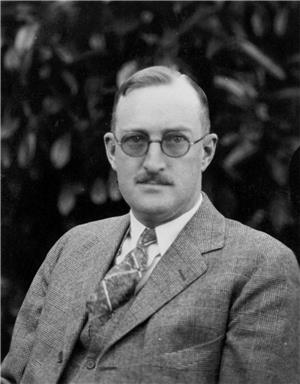Seattle residents saw their first flying machine on June 27, 1908, a balloon flown by L. Guy Mecklem (1882-1973) from West Seattle's Luna Park, and saw another flying machine, a dirigible, in 1909 during the Alaska-Yukon-Pacific Exposition. Charles Hamilton demonstrated the city's first airplane the following year. Herb Munter (1897-1970), a self-educated engineer, was building his own aircraft on Harbor Island by 1915. His efforts attracted the interest of William E. Boeing (1881-1956) and Navy Lt. Conrad Westervelt, who hired Munter to help them build their first airplane, the B&W, in 1916. America's entry into World War I in 1917 lifted the new Boeing Airplane Co. to dizzying heights. Peace two years later sent it into a near-fatal nose dive.
Seattle's love affair with flight was still in its early phase during the summer of 1909, when J. C. "Bud" Mars demonstrated a small gasoline-powered dirigible during the Alaska-Yukon-Pacific Exposition on the then-new campus of the University of Washington. More daring citizens could also ascend from the Exposition grounds in a tethered balloon for an aerial view of their city. Would-be aviators J. Milton Robertson and Ralph Royal also displayed an incomplete "aeroplane" which they claimed to be the first built in Seattle (it lacked an engine and there is no record of it ever flying).
Seattle's First Airplane Flight
Less than a year later, on March 11, 1910, thousands lined the Meadows Race Track in Georgetown to watch Charles K. Hamilton pilot his rickety Curtiss Reims Racer into the air. Seattle's first airplane flights ended abruptly two days later when Hamilton crashed into a pond. He was uninjured and pursued a colorful if short career as a barnstorming airman.
William E. Boeing may have been among Hamilton¹s spectators. The 29-year-old timber magnate had attended the first American air races in Los Angeles in January 1910 and his yacht was being built at Heath Shipyards, just across the Duwamish River from the Meadows track. Boeing was fascinated with flight but his attempts to hitch a ride in an airplane were frustrated until 1915, when he met a kindred soul, Navy Lt. Conrad Westervelt, at Seattle¹s College Club. The two enthusiasts tracked down a visiting pilot, Terah Maroney, and his two-seater float plane on Lake Washington. Boeing took the first turn aloft, and in a sense, he never came down.
The outbreak of World War I convinced Boeing that the government would soon need more airplanes. He and Westervelt enlisted Herb Munter, a self-taught engineer and pilot who built his own planes in a shop on Duwamish Island. Other early Seattle airplane builders and pilots included Thomas Hamilton (who would later found a successful propeller business bought out by Boeing), Verne Backcock, and Walt Edwards.
Boeing traveled to Los Angeles to learn flying from Glenn Martin. He returned with a new seaplane and established the Pacific Aero Club in a Lake Union hangar at the foot of Roanoke Street.
Boeing and Westervelt designed a new float plane, which they dubbed the "B&W" after their initials, and Munter guided construction of a pair prototypes, the Bluebill and Mallard. Boeing took the controls for the Bluebill's brief maiden flight from Lake Union on June 15, 1916. One month later, he incorporated Pacific Aero Products Co. in hopes of producing B&Ws for the Navy.
The Boeing Company Incorporates
Before the end of 1916, the Navy reassigned Lt. Westervelt to other duties and rejected the B&W (the two prototypes were later sold to New Zealand, where they inaugurated that country's first air mail service). Undaunted, Boeing hired a young Chinese engineer, Tsu Wong, to design an improved "Model C" float plane. The U.S. entered the war on April 6, 1917, and confident of government orders, Boeing reincorporated Pacific Aero Products as the Boeing Airplane Co. on May 9.
The Navy promptly commissioned 50 Model C planes for use as trainers and contracted with Boeing for construction of another 50 Curtiss flying boats. Boeing's cousin, Edgar Gott, helped to direct a peak payroll of 337 workers, including many seamstresses who hand-sewed the fabric skins of early aircraft. They mostly worked at the former Heath Shipyards on the Duwamish River in its famous "Red Barn" (since relocated to Boeing Field and restored to serve as a wing of the Museum of Flight).
Peace Stills Boeing
The busy factory fell silent within a month of the signing of the Armistice on November 11, 1918. Military orders evaporated and Boeing had to resort to building furniture and speedboats. The boats proved popular with local bootleggers smuggling Canadian liquor into Puget Sound, but they were not enough to keep the company afloat. Boeing was rescued from the verge of bankruptcy by an Army order for upgrading DH-4 biplanes, but air mail ultimately delivered its post-war salvation.

